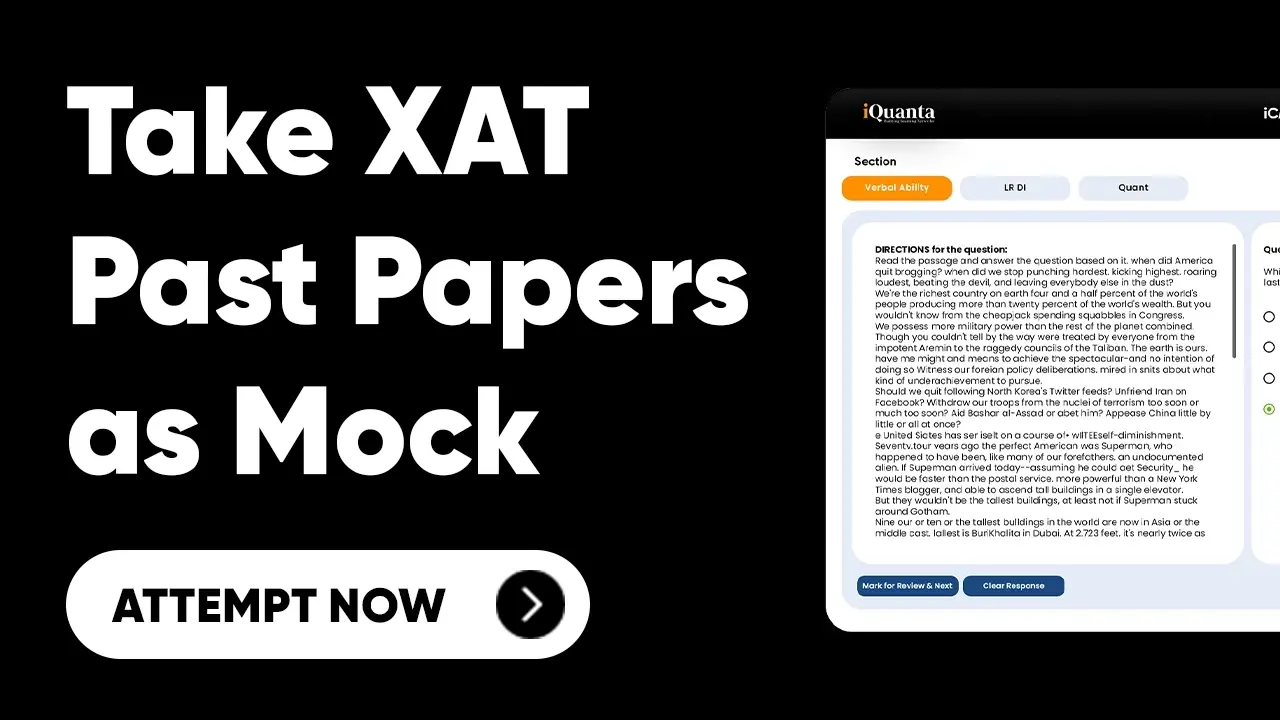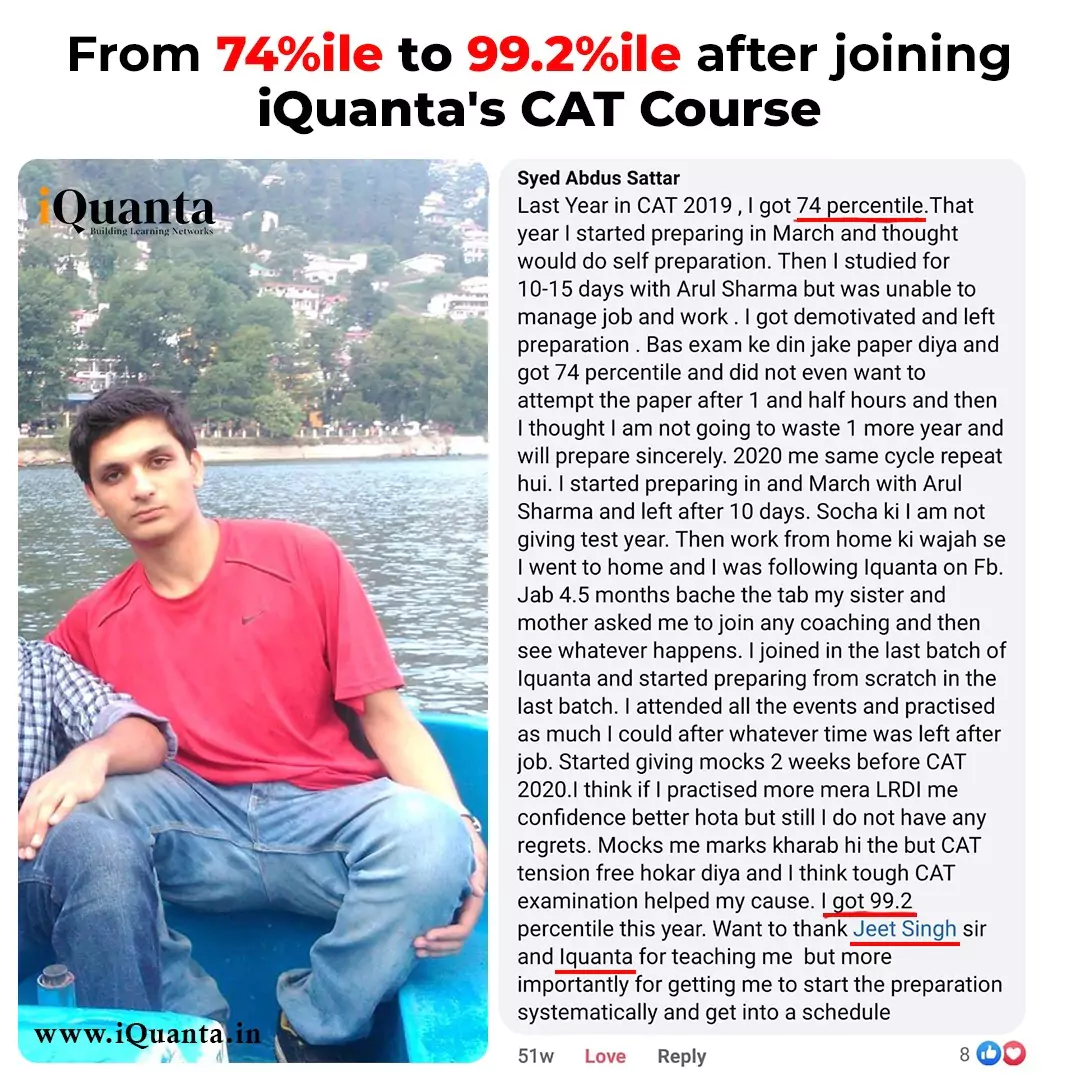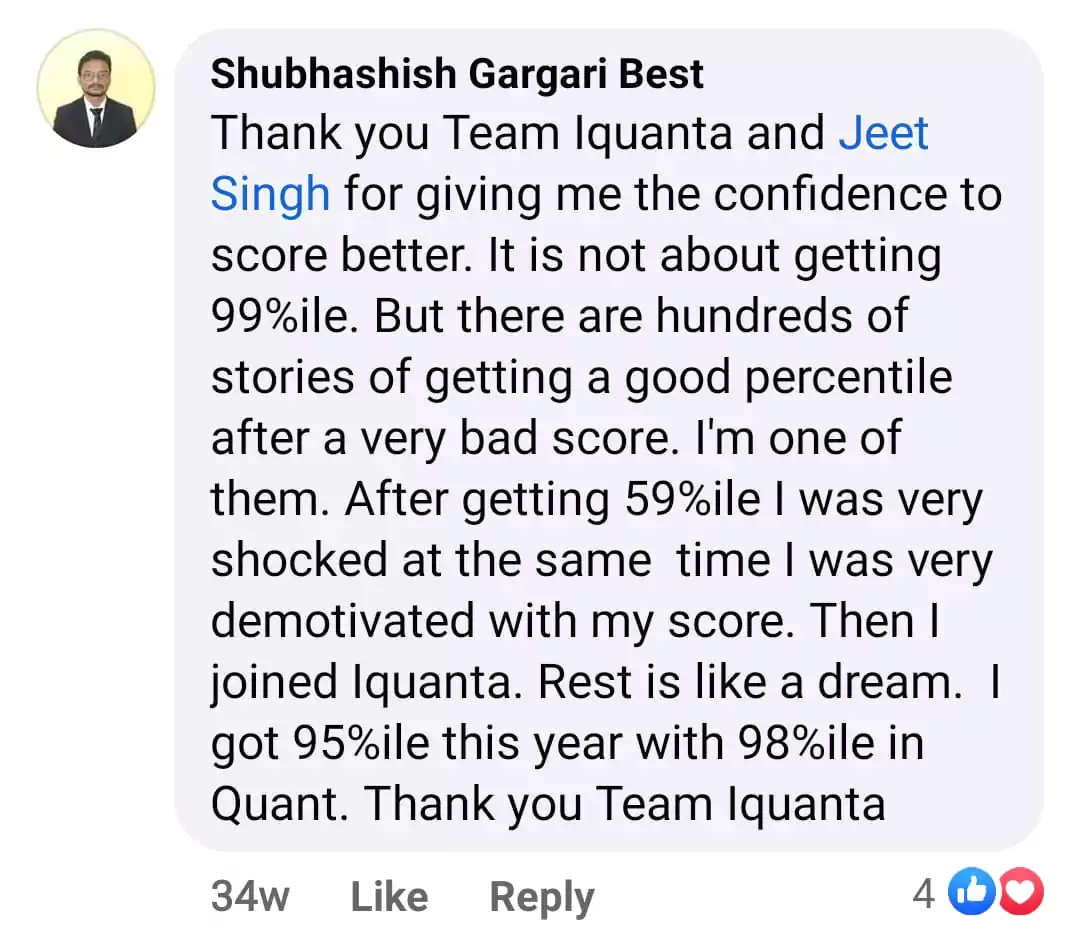Get counselling & free resources
Select your Exams

One of our Team Members will get back in touch with you soon! Have a Great day!

Ask Anything 
iQuanta - MBA | GMAT | IPMAT | CLAT | CUET | IIT-JEE | NEET iQuanta India's
Best XAT Coaching
40,000 Top B-School calls in just 5 years
XAT 2026 Courses
XAT Mock Test Series
XAT Doubt Group
3.5 Lakh+ Members





iQuanta XAT Topper’s Feedback












XAT 2026 Courses
XAT Mock Test Series
XAT Doubt Group
3.5 Lakh+ Members
Apprehension due to Bad Profile or Low %ile?
Low to High %ile







XLRI Converts


 iQuanta XAT 2026 Packages
iQuanta XAT 2026 Packages Free Counselling
Free Counselling iQuanta CAT & XAT Result
iQuanta CAT & XAT Result
Everything about XAT Exam

01
What is an MBA?
MBA or Masters of Business Administration is a Postgraduate degree highly valued in the market. An MBA programme aims to impart a holistic knowledge in the field of Management under Finance, Marketing, Human Resources, Operations and several other domains.
Why MBA?

- Industry Knowledge
- Higher Earnings
- Personality Development
- Better Job Profile
- Networking
- Career Switch

02
Xavier Aptitude Test (XAT)
Institutes Accepting XAT Score:
XLRI Jamshedpur, XIM University, MICA Ahmedabad, IRMA, IMT Ghaziabad &100+ other Colleges.
B-Schools Packages
- XLRI Jamshedpur: 32.70 LPA
- MICA Ahmedabad: 20.09 LPA
- IMT Ghaziabad: 17.35 LPA
- IMI New Delhi: 17.01 LPA
- GIM Goa: 14.87 LPA
| GENERAL PACKAGES | ||
| TOP 5 B-Schools | 19+ LPA | |
| TOP 8 B-Schools | 14+ LPA | |
| TOP 12 B-Schools | 11+ LPA | |
- XLRI Jamshedpur

- IRMA Anand

- GIM Goa


03
XAT EXAM PATTERN
XAT is a computer-based objective test of 190 minutes. The Exam pattern consists of two parts. Part 1 consist of 3 section and Part 2 consist of 2 sections.
Part-1
- Quantitative & DI
- Decision Making
- Verbal and LA
Questions
- 28
- 21
- 26
TIme
- 170
minutes
(No sectional time limit)
Part-2
- General Knowledge
- 20
- 10
minutes
No negative marking
Total
95
3Hrs
Question Type: Objective type question with 5 options to choose from
MARKING SCHEME : +1 for correct and -0.25 for incorrect. Additionally -0.10 marks are deducted after 8 unattempted Questions

04
XAT 2026
IMPORTANT DATES
| EVENTS | XAT 2026 DATES |
| XAT 2026 Notification Release | July 10th, 2025 |
| XAT 2026 Application Process starts | July 10th, 2025 |
| Last Day To Fill XAT 2026 Application Form | Dec 5th, 2025 |
| XAT 2026 Admit Card | Dec 20th, 2025 |
| XAT 2026 Exam date | Jan 4th, 2026 |
| XAT 2026 results | January Last Week |

05
XAT ELIGIBILITY
Here are the minimum academic requirements for basic eligibility for the XAT in 2026:
- Criteria: Final year bachelor's degree candidates or those awaiting their result are also eligible to appear for the XAT exam.
- Candidates with professional qualifications such as CA/CS/ICWA can also appear for XAT
- 10th/12th scores & Graduation Scores do not affect the XAT eligibility.
XAT Score vs Percentile
XAT Score vs Percentile
| Percentile | XAT 2025 (Score) | XAT 2024 (Score) | XAT 2023 (Score) |
|---|---|---|---|
| 99.5%ile | 41 | 36 | 47 |
| 99%ile | 38 | 33 | 43 |
| 95%ile | 31 | 26 | 37.5 |
| 90%ile | 28 | 23 | 32 |
| 85%ile | 25 | 20 | 29 |
| 80%ile | 21 | 18 | 27 |
XAT 2026 Flagship Courses
XAT Syllabus
Verbal and Logical Ability
| Topics | Expected Number of Question |
|---|---|
| RC (4 Set) | 12 Qs |
| Poem Based (1 Set) | 2 Qs |
| Fill in the Blanks | 1-2 Qs |
| Critical Reasoning | 5-6 Qs |
| Grammar | 3-4 Qs |
| Para Jumbles | 3-4 Qs |
| Total | 26 Qs |
Expect 26 Questions in XAT out of these topics
XAT Decision Making
| XAT DM Topics | Number of Questions |
|---|---|
| Set - 1 General Ethical Dilemma | 3 Qs |
| Set - 2 Recruitment related Set | 3 Qs |
| Set - 3 Calculative set | 3 Qs |
| Set - 4 HR Decision Making (Promotion) | 2 Qs |
| Set - 5 HR Hiring (Visually impaired candidates) | 3 Qs |
| Set - 6 Company Internal Disputes | 3 Qs |
| Set - 7 HR Decision Making (Moonlighting) | 2 Qs |
| Set - 8 Tea stall startup | 3 Qs |
| Total | 21 Qs |
Major Questions will be direct MCQ whereas in some you have to find sequence
XAT Quantitative and DI Syllabus
| THE MOST IMPORTANT TOPICS (in terms of weightage) | |||
|---|---|---|---|
| Topic | Expected Number of Question | ||
| Arithmetic | 8-9 Qs | ||
| Algebra | 2-3 Qs | ||
| Geometry | 2-3 Qs | ||
| Number System | 5-6 Qs | ||
| Modern Maths | 1-2 Qs | ||
| Data Interpretation (2 Set) | 6 Qs | ||
| Total | 28 Qs | ||
Expect 28 Questions in XAT out of these topics
To appear for XAT previous year papers in Full Mock format

Learn from the best




Success stories of iQuanta toppers

CAT 100%iler

CAT 99.76%iler

CAT 99.5%iler

CAT 99.92%iler

CAT 99%iler

CAT 99.96%iler

CAT 99.56%iler

CAT 99.97%iler

CAT 100%iler

CAT 99.76%iler

CAT 99.5%iler

CAT 99.92%iler

CAT 99%iler

CAT 99.96%iler

CAT 99.56%iler

CAT 99.97%iler

CAT 99.38%iler

CAT 99.2%iler

CAT 99%iler

CAT 99.11%iler

CAT 99.94%iler

IIM Bangalore

IIM Convert

CAT 99.38%iler

CAT 99.2%iler

CAT 99%iler

CAT 99.11%iler

CAT 99.94%iler

IIM Bangalore

IIM Convert
iQuanta‘s XAT 2026 Free Resources
paid

01
100+ Hours of Conceptual live Stream Classes02
20+ Practice Session03
iQuanta Exclusive Material04
7 XAT Full Mocks05
24*7 Doubt Solving06
XAT Specific Intensive DI Sessions07
XAT Specific VA Sessions for Grammar, Poems and Vocabulary08
XAT Specific 100+ Decision making Sets with Video Solution09
Special Initiatives by Indrajeet Singh iQuanta
free
01
XAT Past Year Papers02
Doubt Solving Group03
XAT LRDI Resources04
XAT level Question Bank05
Download Formula Book06
Download XAT Brochure07
Download MBA Brochure08
iQuanta Youtube Channel09
XAT Specific CR & PJ for Practice10
XAT 150 & DM session by Indrajeet singh.
Everything Included in XAT 2026 Course
iQuanta‘s XAT 2026 Resources
01
Conceptual live Stream Classes 80+ Hours02
15+ Practice Session03
iQuanta Exclusive Material (Per Topic 50 | Total 5000 Quesions)04
XAT Full Mocks 705
24*7 Doubt Solving06
XAT Specific Intensive DI Sessions07
XAT Specific VA Sessions for Grammar, Poems and Vocabulary08
XAT Specific 100+ Decision making Sets with Video Solution09
Special Initiatives by Indrajeet Singh iQuanta
Everything Included in XAT 2026 Course
01
XAT Past Year Papers02
Doubt Solving Group03
XAT LRDI Resources04
XAT level Question Bank05
Download Formula Book06
Download XAT Brochure07
Download MBA Brochure08
iQuanta Youtube Channel09
XAT Specific CR & PJ for Practice10
XAT 150 & DM session by Indrajeet singh.
XAT 2026 Preparation Strategy
It is very important for an aspirant while building their XAT strategy to have a stronghold on all five sections of the syllabus. For that, the aspirant needs to give their equal focus on each section as they can be more confident while giving the exam. For In-Depth prep you can Enrol for iQuanta XAT Course
1. XAT Strategy : Verbal and Logical Ability
This section is a combination of the VARC and the LR portion of the CAT exam. There will be around 26 total questions. Approximately 4 passages are given in this section, 14-16 questions will be asked on the basis of RCs. The verbal ability questions range from 8-10.
You can Read Articles and its summary from here CAT Study Material. iQuanta has 250+ Article with summary for you which you can refer. After developing a regular reading habit, you can now start focusing on your speed. Various online sites can determine your reading speed. RCs require more practice in your reading skills. Start by solving 1–2 RCs a day and then gradually them after you start gaining confidence. Try to analyse the tone and the passages. It will eventually come with time. Practice as many previous year papers for the verbal section as you can. Practice as many previous year papers for the verbal section as you can. You can practice from XAT previous year papers which are available on iQuanta Website for you completely free.
The best XAT strategy for this section would be to put your CAT VARC preparation in use. The passages are way smaller than CAT and often the passages constitute of poems. Sometimes, that makes it hard to comprehend. The vocabulary will be put on test in this section through passages and through the other VA questions which include fill in the blanks with the right choice of words, grammar questions, synonyms, antonyms and other vocabulary tests. There would be questions from Paragraph Jumbles, Paragraph Completion, Critical Reasoning, Statements-Assumptions etc. The paper would not consist of difficult sets of LR but the level of Verbal ability would be higher than CAT.
2. XAT Strategy : Decision Making
Decision Making or often called Business Decision Making is a section that would be new for the candidates. This is a section that has scenarios of business problems or HR problems and tells you to choose the best option or order the options from most effective to least effective to solve the problem given in the question. It consists of 7 to 8 passages that have 2-3 questions each. The total number of questions is 21. The XAT strategy for this section is more or less practising the old set of papers as there is no syllabus for this section. In the XAT 2024, using the logic of the question not your own interpretation helps. Solving Decision Making questions through the lens of Law, Practicing lots of questions from the past year papers is an important part of your XAT strategy.
3. XAT Strategy : Quantitative Ability and Data Interpretation
This section consists of the Quantitative Ability as well as Data Interpretation Questions. There would be 3-4 DI sets and the rest would be Quants. The total number of questions is 28. The Syllabus for Quants and DI would be similar and of the same level of CAT. This section might not need additional preparation. Just more and more practise will sort it out.
To start your XAT preparation for Quantitative Skills, make sure you start from the very basics. Begin with focusing on calculation. Practice speed maths and vedic maths. You can refer to the following videos for some fast calculation tips:
Start preparing from the elementary level Mathematics and then work your way up to the tougher questions. Here at iQuanta, both Live and Conceptual classes are conducted so that the students can learn the concept behind a topic and then apply them to the questions. Try to not rely on the calculator for basic calculations.
There are two approaches while solving a question: general and shortcut way. If you apply the general method, you will not be able to solve all the questions in time. Also, you can solve by using options, but it only works when you have practised lots of questions and have a clear idea of doing it through options.Solve as many questions from every topic, and try to be familiar with all the types of questions by practising lots of varieties.
All you can do for the DI preparation is to practice as many sets as possible. Solve as many previous year papers as possible and appear for mocks. This will help you gain familiarity with the level of XAT exam and what you’re going to deal with.
4. XAT Strategy: General Knowledge and Essay
The list of topics covered in the XAT GK section of the XAT exam is limitless. For the purpose of calculating the percentile, GK scores are not taken into account. This portion, however, cannot be disregarded. During the PI time, the interviewers do examine your grades. You must thus think of it as embracing all the crucial subjects that were examined in the study of prior years.
This is a section of 25 mins where anything and everything can come. It would be from various kinds of current affairs, news, trivia, history, important past events, business etc. People normally spend the least amount of effort on the preparation of this section but it is important that you have a decent score in this section as the professors interviewing you might judge you on this score. The correct XAT strategy for the GK and essay session would be practising more and more from old papers and mock tests. The essay has been reintroduced in the XAT 2022 exam.
There is no negative marking in this section. The essay is evaluated only after being shortlisted by the XLRI.
The Cut-offs and XAT Strategy
One of the key factors of this exam is the sections are not time-bound and you can move across sections. Now, people who are strong in a particular section end up spending more time in that section. So, while they meet the overall cut-off of a particular program, they might fall short on the sectional cut-off. Make sure your XAT strategy helps you make the best out of this. A lot of people fall short of the DM cut-off as they pay less importance to the section or they make too many errors. While the section you find easiest should be done the earliest, a substantial amount of time should be given to the other sections as well. It is suggested that aspirants should write as many mocks as they can in order to judge how much time to give to each section in order to clear the cut-offs of each section. The cut-off goes till 96 because a lot of students in that range fail to meet the sectional cut-offs.
Practice is the Key
The most crucial part of your XAT strategy is to practice. While not much time is usually left after CAT to prepare for XAT, it is really important for the students to practise as much as possible. Taking at least 10 mock tests would help the students understand how the pattern is and how he/she can strategize to ace the exam. Once you know how the pattern is and how to work through it, XAT can be aced nicely. Also, people who often falter in the CAT exam find a breather in XAT and many of them end up getting XLRI to shortlist while they could not manage a good score in CAT. So, the key is not to get demoralised if you have had a poor CAT exam. Also, the CAT results are often timed just before the XAT exam. Keep it in mind that XAT is just another test if you aced CAT already or another lifeline if you faltered in CAT. Do not let the CAT result bother you and ruin this opportunity
summary
Solve daily 30 QA, 3RC, 20VA, 5DM & 3DI Sets apart from iQuanta Classes.




1200+ 99%ilers
& 1200s of
CAT Toppers
40,000 IIM calls in just 5 years








































































1200+ 99%ilers
& 1200s of
CAT Toppers
40,000 IIM calls in just 5 years
iQuanta Toppers

Guru Charan
CAT 99.99%ile

Manav Jain
CAT 99.99%ile

Parikshit Tomar
CAT 99.99%ile

Satyajit Das
CAT 99.97%ile

Swadesh Rath
CAT 99.97%ile

Aditya Singh
CAT 99.95%ile

Souradeep Banerjee
CAT 99.95%ile

Soumbhra mukher jee
CAT 99.94%ile

Rahul dandwate
CAT 99.92%ile

Umesh chandra
CAT 99.91%ile

Dhruv jajoo
CAT 99.91%ile

Nikhil dhing
CAT 99.9%ile

Rounak Tikmani
CAT 99.9%ile

Shubham Garg
CAT 99.9%ile

Venu Goud Amargani
CAT 99.9%ile

Shivam singh
CAT 99.9%ile

Jai Rawal
CAT 99.88%ile

Archit aggarwal
CAT 99.88%ile
.jpeg)
Diwakar singh tanwar
CAT 99.87%ile

Ritvik Manglik
CAT 99.87%ile

Mayukh Roy
CAT 99.87%ile

Nupur Kokate
CAT 99.86%ile

Abhishek mishra
CAT 99.85%ile

RishavBanerjee
CAT 99.83%ile
 XAT 2026 Journey
XAT 2026 Journey XAT Exam Details
XAT Exam Details iQuanta XAT Courses
iQuanta XAT Courses  XAT Resources!
XAT Resources! XAT Toppers & Feedback
XAT Toppers & Feedback
- Call Us: 8130900243
- Contact for Franchises: 9458123637
- Mail: info@iquanta.in
- Address: Ground Floor, 126, Udyog Vihar Phase 4 Rd, Phase III, Udyog Vihar, Sector 19, Gurugram, Haryana 122022
- CATOMET
- NMAT + SNAP 20 Full Mocks
- NMAT 10 Full Mocks
- SNAP 10 Full Mocks
- XAT 7 Full Mocks
- IIFT 5 Full Mocks
- MICAT 5 Full Mocks
- CMAT 7 Full Mocks
- CUET PG 7 Full Mocks
- MHCET 7 Full Mocks
IPMATNEETIIT JEE
- Terms and PoliciesReach out to us
Get your questions answered about learning with iQuanta
- Call: 8130900243
- Ground Floor, 126, Udyog Vihar Phase 4 Rd, Phase III, Udyog Vihar, Sector 19, Gurugram, Haryana 122022
- Follow us at:


